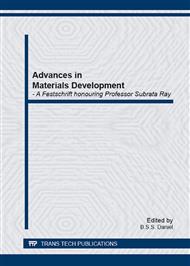[1]
B Daniel, Miracle and Steven L. Donaldson, ASM Handbook, Composites. (2001) 21.
Google Scholar
[2]
Krishan Kumar Chawla, Composite materials: science and engineering, 2nd Edition, (1998).
Google Scholar
[3]
M.K. Surappa, Aluminium Matrix Composites: Challenges & Opportunities, Sadhana 28(2003) 319–334.
DOI: 10.1007/bf02717141
Google Scholar
[4]
A. Miserez, R. Müller, A. Rossoll, L. Weber, A. Mortensen, Particle reinforced metals of high ceramic content, Materials Science and Engineering A 387–389 (2004) 822-831.
DOI: 10.1016/j.msea.2004.05.054
Google Scholar
[5]
F. Bonollo, L. Ceschini And G. L. Garagnani, Mechanical and Impact Behaviour of Al2O3/2014 & Al2O3/6061 Al MMCs in the 298-473k temp range, Applied Composite Materials 4 (1997) 173–185.
DOI: 10.1007/bf02481779
Google Scholar
[6]
T. Das, P. R. Munroe, S. Bandyopadhyay, The effect of Al2O3 particulates on the precipitation behaviour of 6061Al matrix composites, Journal of Materials Science 31 (1996) 5351 5361.
DOI: 10.1007/bf01159304
Google Scholar
[7]
L. Ceschini, G.S. Daehn, G.L. Garagnani, C. Martini, Friction and wear behavior of Al2O3/Al composite under dry sliding conditions, Wear 216 (1998) 229-238.
DOI: 10.1016/s0043-1648(97)00261-5
Google Scholar
[8]
B. Prabhu, C. Suryanarayana, L. An, R. Vidhyanathan, Synthesis and characterization of high volume fraction Al-Al2O3 nanocomposite powders by high-energy milling, Materials Science and Engineering A 425 (2006)192-200.
DOI: 10.1016/j.msea.2006.03.066
Google Scholar
[9]
C. Srinivasa Rao and G.S. Upadhyaya, 2014 and 6061 aluminium alloy based powder metallurgy composite containing Silicon Carbide particles/fibres, Materials and Design 16 (1996) 359-366.
DOI: 10.1016/0261-3069(96)00015-5
Google Scholar
[10]
T. J. A. Doel and P. Bowen, Tensile properties of particulate reinforced MMCs, Composites 27A (1996) 655-665.
Google Scholar
[11]
Halil Arik, Production and characterization of in situ Al4C3 reinforced aluminium based composite produced by mechanical alloying technique, Materials and Design 25 (2004) 31–40.
DOI: 10.1016/s0261-3069(03)00163-8
Google Scholar
[12]
S.M. Zebarjad and S.A. Sajjadi, Microstructure evaluation of Al-Al2O3 composite produced by mechanical alloying method, Materials and Design 27 (2006) 684–688.
DOI: 10.1016/j.matdes.2004.12.011
Google Scholar
[13]
Peter W. Lee, ASM Handbook, Powder Metal Technology and applications 7 (1998).
Google Scholar
[14]
Yiguang Wang, C Suryanarayana and Linan An, Phase transformation in nanometric sized γ-alumina by mechanical milling, Journal of American Ceramic Society 88 (2005) 780-783.
DOI: 10.1111/j.1551-2916.2005.00105.x
Google Scholar
[15]
M. Rahimian, N. Ehsani, N. Parvin and H.R. Baharvandi, The effect of sintering temperature and amount of reinforcement on the properties of Al-Al2O3 composite, Materials and Design 30 (2009) 3333-3337.
DOI: 10.1016/j.matdes.2008.11.027
Google Scholar
[16]
M. Kok, Production and mechanical properties of Al2O3 particle reinforced 2024 aluminium alloy composites, Journal of Materials Processing Technology 161 (2005) 381–387.
DOI: 10.1016/j.jmatprotec.2004.07.068
Google Scholar
[17]
Yung-Chang Kanga, Sammy Lap-Ip Chan, Tensile properties of nanometric Al2O3 particulate reinforced composites, Materials Chem. and Physics 85 (2004) 438–443.
DOI: 10.1016/j.matchemphys.2004.02.002
Google Scholar
[18]
Khairel Rafezi Ahmad et al, The microstructure and properties of aluminium composite reinforced with 65 μm alumina particles via powder metallurgy, The International Conference of Sustainable Materials (ICoSM) (2007).
Google Scholar
[19]
L.A. Dobrza´nski, A. Włodarczyk, M. Adamiak, Structure, properties and corrosion resistance of PM composite materials based on EN AW-2124 aluminium alloy reinforced with the Al2O3 ceramic particles, Journal of Materials Processing Technology 162–163 (2005).
DOI: 10.1016/j.jmatprotec.2005.02.006
Google Scholar
[20]
S.S. Razavi-Tousi et al, Effect of volume fraction and particle size of alumina reinforcement on compaction and densification behavior of Al–Al2O3 nanocomposites, Materials Science and Engineering A 528 (2011) 1105-1110.
DOI: 10.1016/j.msea.2010.09.085
Google Scholar
[21]
Mehdi Rahimian, Naser Ehsani, Nader Parvin, Hamid reza Baharvandi, The effect of particle size, sintering temperature and sintering time on the properties of Al–Al2O3 composites, made by powder metallurgy, Journal of Materials Processing Technology 209 (2009).
DOI: 10.1016/j.jmatprotec.2009.04.007
Google Scholar
[22]
Mehdi Rahimian, Nader Parvin, Naser Ehsani, The effect of production parameters on microstructure and wear resistance of powder metallurgy Al–Al2O3 composite, Materials and Design 32 (2011) 1031–1038.
DOI: 10.1016/j.matdes.2010.07.016
Google Scholar
[23]
A.M. Al-Qutub, I.M. Allam, T.W. Qureshi, Effect of sub-micron Al2O3 concentration on dry wear properties of 6061 aluminum based composite, Journal of Materials Processing Technology 172 (2006) 327–331.
DOI: 10.1016/j.jmatprotec.2005.10.022
Google Scholar
[24]
Bekir Sadık Ünlü, Investigation of tribological and mechanical properties Al2O3–SiC reinforced Al composites manufactured by casting or P/M method, Materials and Design 29 (2008) 2002–(2008).
DOI: 10.1016/j.matdes.2008.04.014
Google Scholar
[25]
A. Włodarczyk-Fligier, L.A. Dobrzański, M. Adamiak, Influence of heat treatment on properties and corrosion resistance of Al-composite, Journal of Achievements in Materials and Manufacturing Engineering 21 (2007) 55-58.
Google Scholar
[26]
E. Saiz, A.P. Tomsia, K. Suganuma, Wetting and strength issues at Al/α–alumina interfaces, Journal of the European Ceramic Society 23 (2003) 2787–2796.
DOI: 10.1016/s0955-2219(03)00290-5
Google Scholar
[27]
S.S. Razavi-Tousi, R. Yazdani-Rad, S.A. Manafi, Production of Al nano composite reinforced by Fe–Al intermetallic, Al4C3 and nano-Al2O3 particles using wet milling in toluene, Journal of alloys and compounds (2011).
DOI: 10.1016/j.jallcom.2011.03.111
Google Scholar


